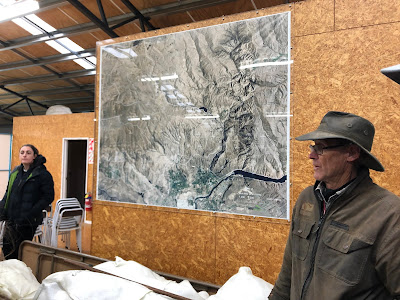 |
| Alistair Campbell describes the variances in paddocks on
Earnscleugh Station. |
On the 16th of May, the group left Alexandra and
headed just outside of town to Earnscleugh Station. This property was
originally purchased in 1862 and has changed owners over the years. The current
owners are Alistair and Judith Campbell, and their son and daughter are also
shareholders of the station. This high country property consists of 25,000
hectares, and they are leasing another 8,000 hectares from a neighbor. They
currently have 25,000 sheep and just over 1,000 head of cattle. Over the years,
they have had to battle the infestation of rabbits on their property. They
currently spend $80,000 a year to keep the population at a controlled level.
They have three breeds of stud cattle including Angus,
Hereford, and Simmental. They also have a four-way cross of the previous three
breeds and the fourth being Gelbvieh. They have an annual bull sale, and this
year’s sale will take place in about a month on June 17th, and they will be
selling 112 bulls. Angus will be the most popular breed at the sale due to the
large demand from restaurants. On average, they are thinking they should get
$17 to $18 per kilo at the sale. The cattle tend to weigh about 100 kilograms
lighter than flatland cattle due to the land of the station being in the high
country of New Zealand. They have been breeding for calving ease like most
cattle operations. They also have been breeding for the cattle to be “lighter
boned” to assist in their ability to navigate the steep slopes and rocky
terrain. The altitude of the station varies from 170 meters to 1,850 meters,
which is 560 feet to 6,000 feet. They tend to get a lot of snow during the
winter up in the high country, and oftentimes if it snows an excessive amount
they will have to use helicopters to bring the cattle down off the mountains
back to the lower paddocks. It was mentioned that the cattle tend to clean up
the paddocks after the sheep by eating the native grasses and annuals on the
property including silver tussock, snow grass, blue tussock, and alpine
herb-field.
 |
| This is a view of the wool shed where the artificial
insemination was taking place with a large pile of “dags” on the floor, which
is the dirty wool from the rear end of the sheep. Even the dirtiest merino wool
is worth up to $5 per kilogram. |
The majority of their 25,000 sheep are merino which produce
a very fine, high-quality wool, but unfortunately have low fertility rates,
which they have been trying to breed out. Through their aggressive breeding
practices and cross-breeding, they were coming across issues with having a
decrease in the quality of the wool. Upon this notice, they have transitioned
their flock genetics back to 87% merino blood lines, which took ten to twelve
years to do so. The Merino wool makes up 55 to 60% of their income, due to its
high-quality and demand in the market.
 |
| This pile of merino wool is 11.8 micron and may be worth up
to $1,000. |
Their flock produces a variety of wool
with microns being the unit of measurement. A micron describes the diameter of
a wool fiber, and merino sheep produce the finest wool. For the wool to be
considered very fine, it has to be smaller than 24 micron. The majority of
their wool is 16.5 micron, which in turn can be used to make Italian suits
costing over $2,000. Once the wool is above 20 microns, it can feel scratchy
against the skin, so merino wool is used for clothing worn against the skin
including sportswear. It also has the ability to absorb sweat without smelling.
The demand for high-quality sportswear is not affected by price as much as work
wear tends to be, as consumers are willing to pay more for sportswear made with
merino wool. When it comes to selling the wool, they have moved away from
auction systems and moved toward forward contracts through the New Zealand
Merino Company. This allows them to lock in prices and follow their wool
through to the manufacturer. One manufacturer they work with is Icebreaker,
which is a popular merino clothing company in New Zealand.
 |
| The sheep are brought in to the wool shed and marked with
blue chalk as they are given a shot of sedative. |
We happened to be at the station on a great day, because
they had veterinarians on the property artificially inseminating their ewes
with Australian semen. Earnscleugh Station AI’s 400 of their ewes, and the vets
can get through about 200 in a day. Artificial insemination results in a 60%
conception rate in their ewes. We were able to see and learn about the entire
process. They bring the sheep into their wool shed and give them a sedative to
calm them down. They are secured to a cradle, the belly is sterilized with an
alcohol solution, they are given a mild anesthetic, and their bellies are
shorn. The vet will sterilize and make two incisions and fill the stomach with
carbon dioxide to inflate it. The semen is stored in 0.25 ml straws stored in
liquid nitrogen. The straw originally had 80 million sperm when it was first
collected, and over time it decreased to 30 million. Using a laparoscope, the
semen is directly injected into the ovaries which allows a more uniform
conception date among the various mobs of sheep.
 |
| Workers shear the belly of a merino sheep to prepare it to
be artificially inseminated. |
 |
| The veterinarian uses a laparoscope to artificially
inseminate a merino ewe. |
 |
| The Clyde Dam which is the third largest hydroelectric dam
in New Zealand. |
Upon departure from the station, we traveled to Queenstown
on our way to Te Anau to stay for the night. Along the way, we traveled through
the Kawerau Gorge and saw the Clyde dam which is New Zealand’s third largest
hydroelectric dam. We also traveled past many orchards and wineries in this
area of the country. Once arriving in Queenstown, we were able to do some
shopping and eat lunch. We later continued our journey alongside Lake Wakatipu,
a glacially formed lake which gave it its great depth reaching 750 feet. We
then arrived in Te Anau for the night.
 |
| This view of Lake Wakatipu from Queenstown is a great
illustration of the weather variances New Zealand can experience, from sunshine
to snowfall in just a few kilometers. |












Comments
Post a Comment